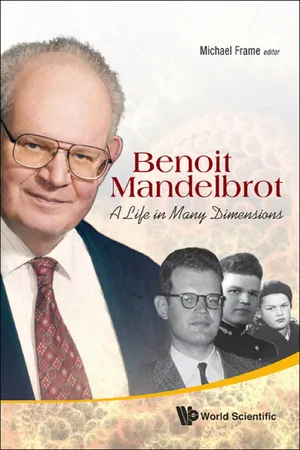
Benoit Mandelbrot: A Life In Many Dimensions
A Life in Many Dimensions
- 400 pages
- English
- ePUB (mobile friendly)
- Available on iOS & Android
About This Book
This is a collection of articles, many written by people who worked with Mandelbrot, memorializing the remarkable breadth and depth of his work in science and the arts. Contributors include mathematicians, physicists, biologists, economists, and engineers, as expected; and also artists, musicians, teachers, an historian, an architect, a filmmaker, and a comic. Some articles are quite technical, others entirely descriptive. All include stories about Benoit.
Also included are chapters on fractals and music by Charles Wuorinen and by Harlan Brothers, on fractals and finance by Richard Hudson and by Christian Walter, on fractal invisibility cloaks by Nathan Cohen, and a personal reminiscence by Aliette Mandelbrot.
While he is known most widely for his work in mathematics and in finance, Benoit influenced almost every field of modern intellectual activity. No other book captures the breadth of all of Benoit's accomplishments.
Contents:
- Introduction — Benoit Mandelbrot: Nor Does Lightning Travel in a Straight Line (M Frame)
- Fractals in Mathematics — Chapters by Michael Barnsley, Julien Barral, Kenneth Falconer, Hillel Furstenberg, Stephane Jaffard, Michael Lapidus, Jacques Peyriere & Murad Taqqu
- Fractals in Physics — Chapters by Amon Aharony, Bernard Sapoval, Michael Shlesinger, Katepalli Sreenivasan & Bruce West
- Fractals in Computer Science — Chapters by Henry Kaufman & Ken Musgrave
- Fractals in Engineering — Chapters by Nathan Cohen & Marc-Olivier Coppens
- Fractals in Finance — Chapters by Martin Shubik & Nassim Taleb
- Fractals in Art — Chapters by Javier Barrallo, Ron Eglash & Rhonda Roland Shearer
- Fractals in History — Chapter by John Gaddis
- Fractals in Architecture — Chapter by Emer O'Daly
- Fractals in Physiology — Chapter by Ewald Weibel
- Fractals in Education — Chapters by Harlan Brothers & Nial Neger
- Fractals in Music — Chapter by Charles Wuorinen
- Fractals in Film — Chapter by Nigel Lesmoir-Gordon
- Fractals in Comedy — Chapter by Demetri Martin
Readership: People interested in the life work of Benoit Mandelbrot. While the technical articles will be accessible mainly to scientists, the range of chapters provides material of interest to a wide range of readers. The audience range from the general public for some parts, through high school and college teachers, to research scientists.
Key Features:
- The chapters are by people who worked directly with Benoit, thus containing some personal stories about those collaborations
- Chapters range from technical expositions of complex fractal dimensions, through descriptions of practical applications in chemical and electrical engineering, to stories about working with Benoit on a film project
- Chapters on fractals in education will be of interest to mathematics teachers, the largest group of people who use fractals
Frequently asked questions
Information


Chapter 2
Benoit Mandelbrot:
nor does lightning travel
in a straight line
Table of contents
- Cover
- Halftitle
- Frontmatter
- Title
- Copyright
- Contents
- Contributors
- Preface by Michael Frame
- Preface by Nathan Cohen
- Chapter 1 Watching Benoit at work
- Chapter 2 Benoit Mandelbrot: nor does lightning travel in a straight line
- Chapter 3 Irregularities and scaling in signal and image processing: multifractal analysis
- Chapter 4 Three-dimensional fractal homeomorphisms
- Chapter 5 Mandelbrot’s cascades: a legendary destiny
- Chapter 6 Benoit Mandelbrot and art
- Chapter 7 The nature of fractal music
- Chapter 8 Fractal antenna and fractal resonator primer
- Chapter 9 Fractal-based wideband invisibility cloak
- Chapter 10 From fractionals Brownian motion to multifractional and multistable motion
- Chapter 11 Watching the markets misbehave
- Chapter 12 Partition zeta functions, multifractal spectra, and tapestries of complex dimensions
- Chapter 13 Benoit Mandelbrot, films, and me: a tribute
- Chapter 14 Fractals and humor
- Chapter 15 Multifractal measures of time series: curvature surfaces of f(α) curves
- Chapter 16 Benoit Mandelbrot, educator
- Chapter 17 The art of roughness
- Chapter 18 Long-range dependence of the two-dimensional Ising model at critical temperature
- Chapter 19 Benoit Mandelbrot, W. H. Freeman, and the launch of The Fractal Geometry of Nature
- Chapter 20 Math and physics: Lévy flights and drives
- Chapter 21 Benoit Mandelbrot in finance
- Chapter 22 How Benoit Mandelbrot changed my thinking about biological form
- Chapter 23 Entropic origin of allometry relations
- Chapter 24 Music and fractals
- Chapter 25 Stories about Benoit
- Chapter 26 Some final thoughts
- Index